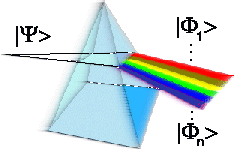Maciej Janowicz and Jan Mostowski
It is shown that solitary-wave, kinklike structures can propagate superluminally in two- and four-level amplifying media with strongly damped oscillations of coherences. This is done by solving analytically the Maxwell-Bloch equations in the kinetic limit. It is also shown that the true wave fronts—unlike the pseudo wave fronts of the kinks—must propagate with velocity c, so that no violation of special relativity is possible. The conditions of experimental verification are discussed.
Phys. Rev. E vol. 73, 046613 - 1-9 (2006) [2/2]
Nov 2, 2005
Beams of electromagnetic radiation carrying angular momentum: The Riemann–Silberstein vector and the classical–quantum correspondence
Iwo Bialynicki-Birula, and Zofia Bialynicka-Birula
All beams of electromagnetic radiation are made of photons. Therefore, it is important to find a precise relationship between the classical properties of the beam and the quantum characteristics of the photons that make a particular beam. It is shown that this relationship is best expressed in terms of the Riemann–Silberstein vector – a complex combination of the electric and magnetic field vectors – that plays the role of the photon wave function. The Whittaker representation of this vector in terms of a single complex function satisfying the wave equation greatly simplifies the analysis. Bessel beams, exact Laguerre–Gauss beams, and other related beams of electromagnetic radiation can be described in a unified fashion. The appropriate photon quantum numbers for these beams are identified. Special emphasis is put on the angular momentum of a single photon and its connection with the angular momentum of the beam.
Opt. Commun. vol. 264, 342-351 (2006) [1/2]
All beams of electromagnetic radiation are made of photons. Therefore, it is important to find a precise relationship between the classical properties of the beam and the quantum characteristics of the photons that make a particular beam. It is shown that this relationship is best expressed in terms of the Riemann–Silberstein vector – a complex combination of the electric and magnetic field vectors – that plays the role of the photon wave function. The Whittaker representation of this vector in terms of a single complex function satisfying the wave equation greatly simplifies the analysis. Bessel beams, exact Laguerre–Gauss beams, and other related beams of electromagnetic radiation can be described in a unified fashion. The appropriate photon quantum numbers for these beams are identified. Special emphasis is put on the angular momentum of a single photon and its connection with the angular momentum of the beam.
Opt. Commun. vol. 264, 342-351 (2006) [1/2]
Subscribe to:
Comments (Atom)
